Search In Parliament screen
The Search In Parliament screen provides collapsible lists of data sources within the Parliament database that help to narrow down your search, and several text boxes for searching in the most common fields. You can change the assortment of fields, and save one or more configurations.
Selecting groups and subsets
The Parliament database is divided into groups of subsets that are listed on the right-hand size of the screen. You can select the entire database by clicking the “Select All” link at the head of the list. You can select and de-select an entire group by clicking the check box to add or remove a tick. Some subsets belong to more than one group.
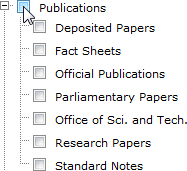
You can expand or contract a group by clicking the plus or minus sign. You can select and de-select individual subsets by clicking the plus sign to display a list, and then clicking a check box to add or remove a tick next to a subset.
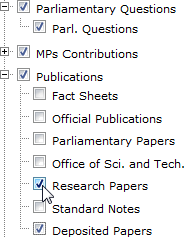
You may need to scroll down to see all of the subsets. The check box for a group turns grey when only some subsets are selected.
Selecting fields
To change the assortment of fields that is available for searching, click the Customise button, and a list of fields will be displayed. You will probably need to scroll down to see all of the fields.
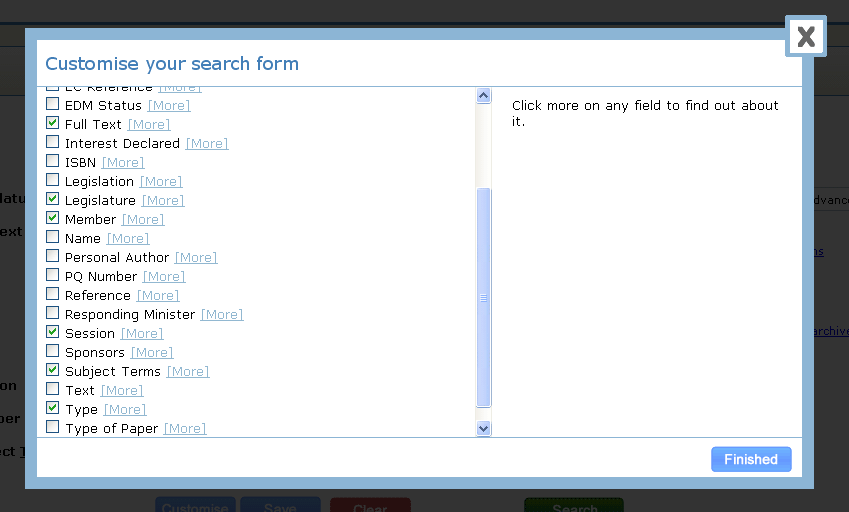
To select an individual field, click to place a tick in the check box next to its name, and the corresponding text box will be added to the search form. Click again to remove the tick and de-select the field.
If the name of a field is dimmed, then it is not used in the subsets that you have chosen, and it cannot be selected.
Click the [More] link next to the name of a field to see the groups in which it is used, and other information.
Form configurations
If you would like to be able to use your preferred collection of search fields when you come to the Search In Parliament screen, add and remove fields until you have the selection that you want, and then click the “Save button beneath the form:
![]()
Give your configuration a name, click the “Save” button, and it will be added to the list in unded the Saved heading on the right hand side of the screen, and in the Search Preferences section of My Justis.
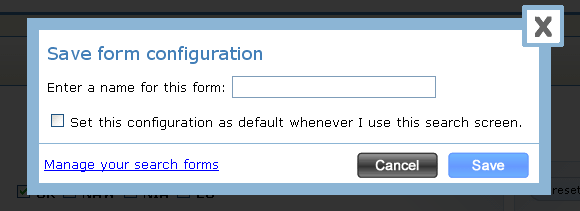
You can save more than one collection of fields, and load the one you want by clicking the name of your form from the Saved list.
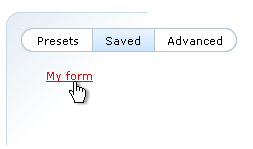
You can make one of your configurations the default, so that you see your preferred selection of fields each time that you go to the Search In Parliament screen, by clicking the check box and then clicking the “Done” button
You can manage your search forms (including deleting one or more of your configurations) in the Search Preferences section of My Justis.
Searching
Type your search terms into the text boxes, and then click the “Search” button just below the text boxes (some browsers allow you to press the Enter key on your keyboard).
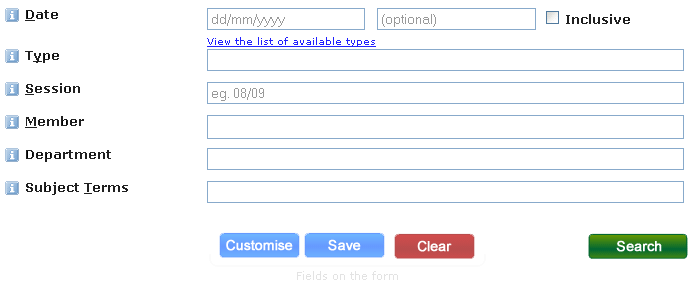
There is one text box for each of the commonly-used fields in the Parliament database. You can change the assortment of fields. There is also a text box for Full Text; terms that you type here will be searched for in all fields.
If you are not sure of the spelling of a word, or if you want to see variations of spellings, Justis can make suggestions as you type, even allowing for wild cards:

Use the up and down arrow keys until the word you want is highlighted. Then either press Enter (to select a word and start a search) or press the right arrow key (to select a word without starting a search). You can also click a word with your mouse, to select it without starting a search.
Suggestions appear when you have typed 4 characters. You can turn the Suggest function off or on in the Search Preferences section of My Justis.
You can use search operators to control the relationship between multiple terms within a field. You can also use wild cards to look for variants of your terms.
An AND operator is automatically used between terms and between fields. If you want to use OR or NOT operators between terms, just type them in. If you want to use OR or NOT operators between fields, then you must use the Full Text box.
When you have typed all of the terms for which you wish to search, click the “Search” button just below the text boxes (some browsers allow you to press the Enter key on your keyboard).
![]()
If your search finds more than one record, you will be shown a list of documents on the Results screen. If your search finds only one record, it will be displayed on the Document screen. If your search finds no records, you will see a message informing you of this.
If you want to clear the entries that you have made in the text boxes, click the “Clear” button just above the text boxes.
You can save your search strategies so that you can use them again without having to re-type them, by clicking “Save Search” in the Results Options panel on the Results screen.
search-in-parliament.html; last updated 15th June 2009
Copyright © 2008–2009 Justis Publishing Limited